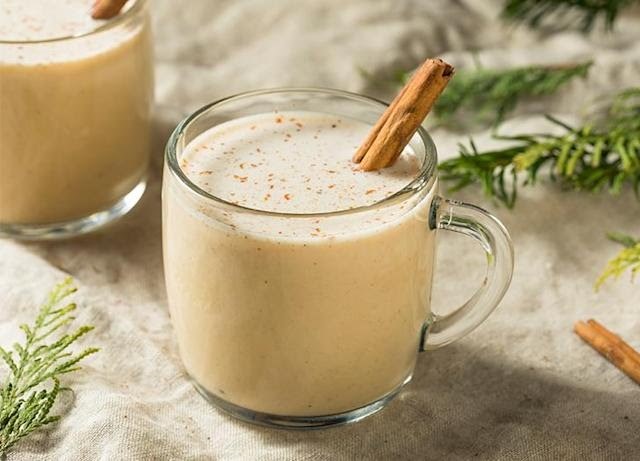
You’ve tried eggnog over and over again, but for some reason, you just can’t get down with the custardy Christmas bev. But that doesn’t mean you’re limited to mulled wine and hot apple cider. Meet coquito, a coconutty concoction from Puerto Rico that’s sipped all over the island and beyond during the holidays. It’s creamy, boozy and—most importantly for eggnog haters—usually egg-free. We asked Chef Hector Prieto, executive sous chef at Caribe Hilton in San Juan, Puerto Rico, how to make coquito at home. Read on for the drink’s history and his real-deal coquito recipe.
What Is Coquito?
Translating to “little coconut” in Spanish, coquito is a coconut-based cocktail that’s similar to eggnog in the sense that it’s creamy, spiked with liquor and served at Christmas (but it’s different in that it usually doesn’t contain eggs). Coquito is one of many creamy, dairy-laced drinks that are enjoyed during the holidays throughout Latin America, South America and the rest of the world, like rompope in Mexico and crème de vie in Cuba. It can be prepared with an array of winter spices (though cinnamon and nutmeg are basically nonnegotiable), and there are a range of flavored versions that can be found around the island, made with everything from pineapple to pumpkin.
“The origin of coquito is still unknown, but the famed holiday drink is usually made and consumed only during the holiday season,” says Prieto. “Coquito marks the arrival of Christmas on the island.” Some families drink it as early as Thanksgiving and as late as Día de los Reyes, or the Epiphany, on January 6, a Christian feast day that celebrates the Magi visiting Jesus.
Coquito’s history isn’t cut-and-dried, but it’s theorized that Spanish colonizers brought their version of eggnog, posset, to the island. (Posset, which dates back to medieval times, is a term used for drinks made with hot milk that’s curdled with some sort of alcohol or citrus juice.) There, it was infused with local Puerto Rican rum, but many varieties have sprung up as a result of the Spanish settling across the Caribbean and beyond.
Many other nations use rum in their eggnog-like bevs (like Panama’s ron ponche and Venezuelan ponche crema), but coconut is what makes coquito uniquely Puerto Rican. (Just for the record though, coconut was a colonial import brought to the island from West Africa by Spanish settlers—it’s only been cultivated in Puerto Rico since the 1500s.) Some O.G. recipes involve cracking a ripe coconut and scooping out its pristine flesh, but nowadays, coconut milk and coconut cream are the go-to ingredients. Canned condensed milk and evaporated milk eventually became key components after the Spanish-American War, once U.S. governance brought the shelf-stable ingredients to the island.
Coquito has become increasingly popular stateside in recent years, a trend Prieto chalks up to Latin culture’s ever-growing exposure in the U.S. “Not only Puerto Ricans, but many Latins are now living in the US,” he says. “The same thing is happening with local dishes such as mofongo, pigeon pea rice and alcapurrias.”
Yahoo
PureWow
What Is Coquito? We Asked a Puerto Rican Chef for His Authentic Holiday Recipe
[email protected] (PureWow)
December 14, 2021, 8:00 am
You’ve tried eggnog over and over again, but for some reason, you just can’t get down with the custardy Christmas bev. But that doesn’t mean you’re limited to mulled wine and hot apple cider. Meet coquito, a coconutty concoction from Puerto Rico that’s sipped all over the island and beyond during the holidays. It’s creamy, boozy and—most importantly for eggnog haters—usually egg-free. We asked Chef Hector Prieto, executive sous chef at Caribe Hilton in San Juan, Puerto Rico, how to make coquito at home. Read on for the drink’s history and his real-deal coquito recipe.
RELATED: How to Make a Piña Colada at Home, According to the Hotel Bar That Invented It
What Is Coquito?
Translating to “little coconut” in Spanish, coquito is a coconut-based cocktail that’s similar to eggnog in the sense that it’s creamy, spiked with liquor and served at Christmas (but it’s different in that it usually doesn’t contain eggs). Coquito is one of many creamy, dairy-laced drinks that are enjoyed during the holidays throughout Latin America, South America and the rest of the world, like rompope in Mexico and crème de vie in Cuba. It can be prepared with an array of winter spices (though cinnamon and nutmeg are basically nonnegotiable), and there are a range of flavored versions that can be found around the island, made with everything from pineapple to pumpkin.
“The origin of coquito is still unknown, but the famed holiday drink is usually made and consumed only during the holiday season,” says Prieto. “Coquito marks the arrival of Christmas on the island.” Some families drink it as early as Thanksgiving and as late as Día de los Reyes, or the Epiphany, on January 6, a Christian feast day that celebrates the Magi visiting Jesus.
Coquito’s history isn’t cut-and-dried, but it’s theorized that Spanish colonizers brought their version of eggnog, posset, to the island. (Posset, which dates back to medieval times, is a term used for drinks made with hot milk that’s curdled with some sort of alcohol or citrus juice.) There, it was infused with local Puerto Rican rum, but many varieties have sprung up as a result of the Spanish settling across the Caribbean and beyond.
Many other nations use rum in their eggnog-like bevs (like Panama’s ron ponche and Venezuelan ponche crema), but coconut is what makes coquito uniquely Puerto Rican. (Just for the record though, coconut was a colonial import brought to the island from West Africa by Spanish settlers—it’s only been cultivated in Puerto Rico since the 1500s.) Some O.G. recipes involve cracking a ripe coconut and scooping out its pristine flesh, but nowadays, coconut milk and coconut cream are the go-to ingredients. Canned condensed milk and evaporated milk eventually became key components after the Spanish-American War, once U.S. governance brought the shelf-stable ingredients to the island.
Coquito has become increasingly popular stateside in recent years, a trend Prieto chalks up to Latin culture’s ever-growing exposure in the U.S. “Not only Puerto Ricans, but many Latins are now living in the US,” he says. “The same thing is happening with local dishes such as mofongo, pigeon pea rice and alcapurrias.”
How to Make Coquito
Many coquito recipes don’t require any cooking. Instead, the liquid ingredients and spices are simply blended and chilled. But Caribe Hilton uses heat to thicken the concoction and meld the flavors as much as possible. Cooking the coquito on the stove also keeps the ingredients from separating and gives the drink a longer shelf life. (If you’re using a coquito recipe that calls for eggs though, you’ll have to cook it so it’s safe to drink.)
The perfect coquito, according to Prieto, is “not too sweet, but [has] just the right balance of cinnamon, coconut and rum.” It should be well spiced so you can taste cinnamon and nutmeg in every sip (the stovetop steeping helps with that), but it should still be bursting with tropical flavor and laced with the clean, sweet flavor of rum.
Caribe Hilton’s coquito recipe calls for Ron del Barrilito (aka little barrel rum), which is a brand of premium aged sipping rums from Puerto Rico. It’s packed with notes of almond, vanilla and raisins, which pair beautifully with coquito. But if you can’t find it near you, Prieto suggests using ron cañon (homemade sugarcane rum) if you’re feeling ambitious or any type of store-bought white rum, like Bacardí.
As for the milks, you can use any brand you like, although we’re partial to Coco Lopez’s coconut cream. (That’s Caribe Hilton’s go-to, and they literally invented the piña colada, so we like to follow suit whenever possible.) We’d also spring for pure vanilla extract and fresh spices if you’re serving your coquito to company.
Prieto stresses that the preparation is simple, but the most important step is making sure all the ingredients are refrigerated before and after preparation for both safety and flavor.
Caribe Hilton’s Coquito Recipe
Ingredients
12 ounces unsweetened coconut milk
12 ounces evaporated milk
12 ounces coconut cream
12 ounces sweetened condensed milk
3 tablespoons ground cinnamon
5 cinnamon sticks
2 tablespoons vanilla extract
4 cups rum
Ground nutmeg, for serving
Directions
Combine all the ingredients except the rum and nutmeg in a large pot over medium heat. Bring the mixture to a gentle boil while stirring constantly, then let it simmer and continue to mix until the spices are aromatic and the mixture is well combined, about 5 to 8 minutes.
Remove the pot from the heat to cool and let the mixture come to room temperature.
Add the rum to the pot and stir until combined. Fish out the cinnamon sticks. Transfer the mixture to a pitcher and let it chill in the refrigerator for at least four hours.
Serve the coquito cold in shot or rocks glasses. Garnish with nutmeg and/or cinnamon sticks.
Ways to Serve Coquito for the Holidays
Coquito is typically enjoyed in shot glasses after dinner, but you can serve it whenever (and however) you’d like. “My favorite way to serve coquito is as a welcome drink to guests,” says Prieto.
You can set out a cold pitcher of it for your relatives to serve themselves with appetizers. It pairs well with fruit, cheese and nuts, in case you have a charcuterie board in mind. But you can also use it to wash down hearty Puerto Rican mains, like pernil asado (roast pork), plantains, arroz con gandules, shrimp stew and bacalaitos (fried salted cod). Because of coquito’s sweet flavor and the spices it’s infused with, you can even serve it with dessert, if you have something like chai crème brûlée or pumpkin pie on the table. “It pairs really well with cinnamon cookies, local white cheese, chocolate and guava, to name a few,” assures Prieto.
Last but not least, you can sip it solo, because coquito certainly doesn’t need any help in the deliciousness department.
https://www.yahoo.com/lifestyle/coquito-asked-puerto-rican-chef-160000183.html

I will have less of a presence on The Torrid Tribe Community. We have very little activity here. This is a sign to me that members have found other social media resources that they are spending more time in. I am happy to see less censorship on social media in general. I started The Torrid Tribe 4 years ago when we were in a state of censorship and lockdowns. It was a difficult time and this was a haven and sanctuary for so many.
I will be lightly posting things here to give you all content to see. This community will always be open to everyone and will resurrect to its full capacity if subscribers show they want it fully operational again with full time administration.
Thank you for being a part of this community. Sending each of you hugs.
K-
Creator of The Torrid Tribe

Passion is the vibe that I want to bring to this community. I want to enjoy your passion for whatever it is you are into. Let's share what we learn - and learn what each other shares. Foodies unite. I love to cook and share recipes. I will regularly post pictures and recipes are available upon request. I would enjoy discussing your past, present and future journeys. Nature is God and Mother Earth's exquisite gift to us. Share a picture and we will enjoy the beauty through your eyes. Let's get deep and consensual with great subjective matter. This is a non judgemental safe place to let everything hang out.
Thank you for your membership contribution subscription. It sponsors our frequent zooms.
For those members that are enjoying this Community, Please consider subscribing. Your commitment will help this Community thrive.
Thank you and hugs.
Torri
Texas, meet your would-be Senator:
A woman who never met a microphone she didn’t French-kiss, a grievance she didn’t adopt, or a Republican she couldn’t reduce to a racist caricature faster than you can say “Remember the Alamo” (And if the Alamo offends somebody she’ll want it torn down).
”So strap in, Lone Star patriots. The 2026 Senate race just got a new theme song, and it goes a little something like this:
♫ Running for Senate—she was born to grouse
Loudest gabbing mouth in the whole damn House,
Kilt her a bill when she was only three,
Huge eyelashes are helping her to see…
Jasmine… Jasmine Crockett, Queen of the Ghetto Frontier! ♫















